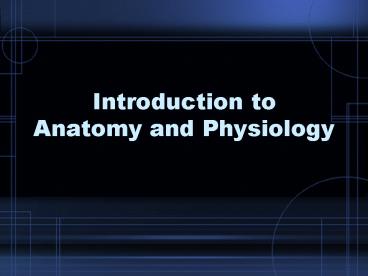Introduction to Anatomy and Physiology - PowerPoint PPT Presentation
1 / 33
Title:
Introduction to Anatomy and Physiology
Description:
Introduction to Anatomy and Physiology – PowerPoint PPT presentation
Number of Views:310
Avg rating:3.0/5.0
Title: Introduction to Anatomy and Physiology
1
Introduction to Anatomy and Physiology
2
What is Anatomy?
- Anatomy is define as the study of the structure
of an organism and the relationship of its parts.
- Derived from two Greek words
- ana up
- temos or tomos cutting
3
Gross Anatomy
- Gross anatomy is used to describe the study of
body parts visible to the naked eye. - Andreas Vesalius is considered the founder of
modern anatomy.
4
And Now
Then...
5
Cytology and Histology
- Cytology is the microscopic study of cell.
- Histology is the microscopic study of tissues.
6
Pathology
- The study of diseased body structures.
7
What is Physiology
- Physiology is the science that treats the
functions of the living organism and its parts. - Derived from two Greek words
- physis nature
- logos science or study
8
Levels of Organization
9
Atomic and Molecular Level
- Atoms are the smallest particles of a chemical
element. - When two or more atoms are joined a molecule is
the result. - Macromolecules are large, complex chemicals made
of combinations of molecules.
10
Organelle Level
- An organelle may be defined as any structure
made of molecules organized in such a way that it
can perform a specific function.
11
Cellular Level
- The smallest and most numerous structural units
that possess and exhibit all the basic
characteristics of living matter. - Cells differentiate to perform different
functions.
12
Tissue Level
- A group of a great many similar cells that all
developed together from the same part of the
embryo and are all specialized to perform a
certain function.
13
Organ Level
- An organ is a structure that is made up of
several different kinds of tissues so arranged
that together, they can perform a special
function.
14
System Level
- The system level of organization involves
varying numbers and kinds of organs so arranged
that, together they can perform complex functions
for the body.
15
Organism Level
- The living human organism is certainly more than
the sum of all of its parts.
16
Overview Of The Eleven Human Body Systems
17
Support and Movement
18
Integumentary System
- Principal Organs
- Skin
- Hair
- Nails
- Primary Function(s)
- Protects against pathogens
- Helps regulate body temperature
- Vitamin D production
19
Skeletal System
- Principal Organs
- Bones (joints)
- Cartilage
- Tendons
- Ligaments
- Primary Function(s)
- Provides structure
- Supports and protects internal organs
20
Muscular System
- Principal Organs
- Muscles (skeletal, cardiac, and smooth)
- Primary Function(s)
- Provides structure
- Supports and moves trunk and limbs
- Helps move substances through the body
21
Communication, Control and Integration
22
Nervous System
- Principal Organs
- Brain
- Spinal Cord
- Nerves
- Sense organs and receptors
- Primary Function(s)
- Controls and coordinates body movements and
senses - Monitors and maintains body systems
23
Endocrine System
- Principal Organs
- Endocrine glands
- Hormones
- Primary Function(s)
- Maintain homeostasis
- Regulates metabolism
- Water and mineral balance
- Growth and sexual development
- Reproduction
24
Transportation and Defense
25
Cardiovascular System
- Principal Organs
- Heart
- Blood vessels
- Blood
- Primary Function(s)
- Transports nutrients and wastes to and from all
body tissues
26
Lymphatic System
- Principal Organs
- Lymph nodes
- Spleen
- Lymph vessels
- Primary Function(s)
- Cleans and returns tissue fluid to the blood
- Destroys pathogens that enter the body (immunity)
27
Lymph Vessels and Nodes
28
Respiration, Nutrition andExcretion
29
Respiratory System
- Principal
- Air passages
- Lungs
- Primary Function(s)
- Supplies blood with oxygen and carries away
carbon dioxide - Speech
30
Digestive System
- Principal Organs
- Mouth and esophogus
- Stomach
- Liver
- Pancreas
- Small and Large Intestine
- Primary Function(s)
- Stores and digests food
- Absorbs nutrients
- Eliminates wastes
31
Excretory System
- Principal Organs
- Kidneys
- Ureters
- Bladder
- Urethra
- Skin
- Lungs
- Primary Function(s)
- Eliminate waste
- Maintain water and chemical balance
32
Reproduction andDevelopment
33
Reproductive System
- Principal Organs
- Ovaries
- Uterus
- Mammary glands
- Testis
- Primary Function(s)
- Produce gametes and offspring































